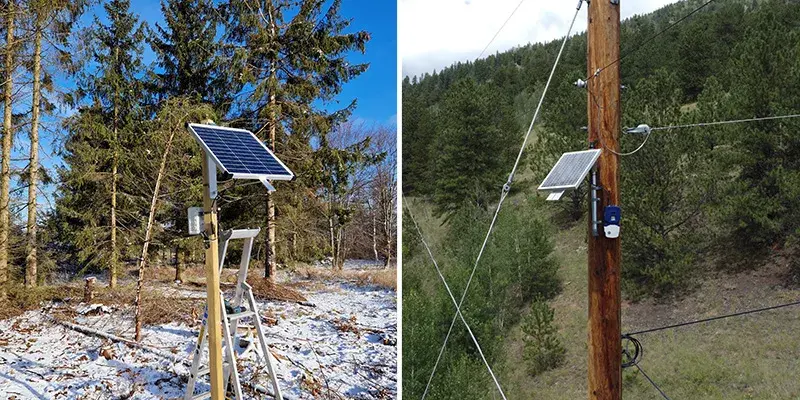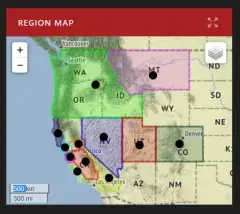S&T is piloting smoke detection sensors ahead of the 2023 wildfire season
Resilience is a broad topic that essentially means being able to weather a storm. Whether that storm is manmade, like a cyberattack on digital infrastructure, or a literal storm, like a hurricane, our ability to quickly recover with minimal disruption is a test of our resilience. It’s the stuff emergency response is made of and it’s a multifaceted endeavor. And it all starts with monitoring. You can plan endlessly for worst-case scenarios, but if you don’t know when an emergency is happening, then you don’t know when it’s time to enact those plans. Rapid confirmation of an impending crisis is often critical when it comes to preserving life and property. Monitoring allows all the moving pieces of an emergency response to launch into action and for decision makers to have as much time as possible to assess and mitigate the threat. This is certainly true when it comes to wildfires.
It should come as no surprise that the Science and Technology Directorate (S&T)—an agency dedicated to developing the capabilities needed to strengthen our national security and save lives—takes wildfire monitoring and resilience quite seriously. S&T has conducted extensive research, development, testing, and evaluation in this area, funding wildfire sensor technology in California just last year, and now its sights are set on Oregon. This coming wildfire season, two types of sensing technologies will be deployed across Oregon’s Willamette Valley.
The devices, developed by Breeze Technologies UG of Hamburg, Germany, and N5 Sensors, Inc. of Rockville, Maryland, were installed in late January and early February. Both companies were participants in S&T’s Smart City Internet of Things Innovation (SCITI) Labs program, undergoing rigorous evaluation to progress to this point.

"This work is crucial not only to protecting communities in the short-term, but to mitigating the impacts of a changing climate on natural and social systems for generations to come,” explained Jeff Booth, lead for S&T’s Sensors and Platforms Technology Center. “Environmental events like a wildfire can be incredibly dynamic. The real-time data from these sensors will provide great insight as we protect the public and build resilience.”

The deployment is a partnership between S&T and the Oregon Hazards Lab (OHAZ) at the University of Oregon and will serve as a test to prove the viability and reliability of the two types of smoke detection sensors during an extended period. OHAZ is a natural fit for this type of effort. The full-time staff and student researchers there strive to cultivate real-time sensing capabilities that provide scientists with curated, open-access data, deliver actionable information to emergency managers and the public, and foster scientific research and discovery for a more disaster-resilient society. Also key to this effort is the ALERTWildfire program, a consortium of the University of Nevada, Reno, University of California San Diego, and the University of Oregon, which will further facilitate the monitoring by providing a high-speed camera system with machine learning capability to spot and track potential wildfires.

The ALERTWildfire network consists of 700 total cameras across the West Coast. OHAZ is responsible for installing and maintaining the 30+ cameras located in Oregon. The cameras can zoom, rotate, and tilt, enabling fire managers to watch the landscape, fire behavior, and weather in real-time. Time lapse imagery is also available on demand. Firefighters, first responders, and incident commanders have direct camera control through its secure web access. ALERTWildfire’s HD cameras have near-infrared capabilities and up to 32x zoom, with a range of up to 40 miles in the daytime and 60-80 miles at night. It’s also worth noting that ALERTWildfire is a high-bandwidth system that enables anyone with internet connectivity to view its public-facing video feeds. This 24/7 access to fire cameras provides enhanced situational awareness for the public that could facilitate faster and safer evacuations.
The wildfire sensors will be deployed in locations where OHAZ is currently operating ALERTWildfire cameras or seismic sensors. Data collected from the wildfire sensors will be monitored and analyzed by Breeze Technologies and N5 Sensors and shared with the team from OHAZ. The goal: validate the wildfire sensor performance against the alerts generated by the ALERTWildfire camera system.
“We at the Oregon Hazards Lab are thrilled to be part of this exciting program,” said Dr. Nick Maggio, OHAZ Assistant Director of Wildfire Technology. “The deployment of the N5 and Breeze sensors, together with our ALERTWildfire camera system, will create a cutting-edge wildfire management platform. This groundbreaking use of multiple independent sensors and artificial intelligence algorithms for the detection of fire will be a profound advancement.”
The combination of smoke detectors seeking out telltale particulates in the air and the advanced camera network providing constant visual situational awareness will allow first responders to discover, locate, and confirm fire ignition; quickly scale fire resources up or down appropriately; and monitor fire behavior throughout the containment process.
The wildfire sensor deployment is expected to last throughout the 2023 wildfire season. Findings from the deployment will be used to further enhance the sensors and their detection capabilities. They will also help to optimize future deployments and locations.
This project will contribute to building a more resilient, just, and livable future of enhanced emergency preparedness, environmental stewardship, and ecological understanding. It was made possible through S&T and SCITI Labs, the Virginia Innovation Partnership Corporation, and Chicago-based TechNexus Venture Collaborative. This pilot program is just the first of many deployments with state and local partners that will contribute to early wildfire detection.
For more information on the sensors or related media inquiries, contact STMedia@hq.dhs.gov.
